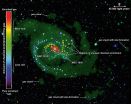(Press-News.org) This news release is available in German.
A method known as navigated transcranial magnetic stimulation (nTMS) has been gaining importance in neurosurgery for some time now. Among other applications, it is used to map brain tumors before an operation and to test whether important regions of the brain, for example motor and language areas, are affected. Doctors at the Technische Universität München (TUM) have now shown that preoperative nTMS analysis of motor areas improves the prognosis of patients with malignant brain tumors.
With the help of nTMS, it is possible to identify what areas of the brain control motor or language function to an accuracy of four millimeters. "That's particularly important, as it enables the removal of tumors from patients without affecting functional areas while at the same time removing as much of the malignant tissue as possible," explains Dr. Sandro Krieg, working group leader at the Department of Neurosurgery of TUM University Hospital Klinikum rechts der Isar and head of the study. Mapping must be performed separately for each patient, as tumors can displace important brain areas from their original sites.
Map for important motor areas
To determine motor areas with the nTMS technique, the physician scans points at defined positions on the patient's head using a coil. The coil induces brief painless electrical pulses in the brain, which stimulate brain neurons at those positions. If the pulses at a given position point activate neurons that trigger muscle movements, the scientists are able to measure the muscle activities with the help of electrodes fastened to the patient's arms and legs. That position is then regarded as an essential location for motor activity.
Up to 150 individual position points per patient can be analyzed and mapped. "In this way, we can draw up a map of important motor areas and nerve pathways in the vicinity of the tumor. During the operation, this data is a good guide as to where we can and cannot cut," explains Krieg. The method has been used at Klinikum rechts der Isar since 2010.
nTMS analysis improves prognosis
In their recent study, Sandro Krieg and his team scanned and mapped motor areas in patients with high-grade gliomas (HGG), which are usually associated with a poor prognosis. They compared two groups: 70 subjects who underwent preoperative nTMS analysis and 70 patients who underwent tumor surgery before nTMS became a standard procedure in the hospital.
The results of the study show the advantage of nTMS mapping for patients compared to the control group: smaller openings in the skull had to be made in patients who underwent nTMS tumor analysis, and residual tumor tissue was left behind less frequently. In addition, their average hospitalization period was two days shorter. Because the general state of health of the nTMS-treated patients was also better, an increased number of them were subsequently able to receive radiotherapy. Above all, those patients survived several months longer than the control group.
"Of course, we need to confirm the findings in larger patient groups, but one important thing is clear: preoperative tumor mapping positively influences many aspects of the procedure," Krieg says about the results, adding: "Some tumors that are otherwise thought to be inoperable can be removed by this method."
Refining protocols for nTMS
The scientists now aim to improve standard protocols for nTMS and, for example, the mapping of language areas. In a recent study, they showed that an object-naming test is the best method for analyzing language centers. "Language areas can already be mapped with nTMS, but they're much more complex than motor areas. We want to create higher standards in order to help patients with tumors in these regions as effectively as possible," the scientist says.
INFORMATION:
Download high resolution pictures: https://mediatum.ub.tum.de/?id=1254186#1254186
Original publications
S. M. Krieg, N. Sollman, T. Obermüller, J. Sabih, L. Bulubas, C. Negwer, T. Moser, D. Droese, T. Boeckh-Behrens, F. Ringel, B. Meyer, Changing the clinical course of glioma patients by preoperative motor mapping with navigated transcranial magnetic brain stimulation, BMC Cancer, April 2015.
DOI: 10.1186/s12885-015-1258-1
T. Hauck, N. Tanigawa, M. Probst, A. Wohlschlaeger, S. Ille, N. Sollmann, S. Maurer, C. Zimmer, F. Ringel, B. Meyer, S. M. Krieg, Task Type Affects Location of Language-Positive Cortical Regions by Repetitive Navigated Transcranial Magnetic Stimulation Mapping, PLOS ONE, April 2015.
DOI: 10.1371/journal.pone.0125298
Contact
PD Dr. Sandro M. Krieg
Department of Neurosurgery
Klinikum rechts der Isar der Technischen Universität München
Tel.: +49 170 - 2039430
sandro.krieg@lrz.tum.de
ANN ARBOR, Mich. -- A team of researchers at the University of Michigan Health System has developed a risk prediction model that helps identify which hepatitis C patients have the most urgent need for new anti-viral drugs.
Rallying baby boomers to be screened for hepatitis C took off as effective treatments emerged to wipe out the liver-damaging virus. But high costs that can rise to more than $80,000 for a round of treatment have complicated the promise of providing curative treatment for the estimated 3.2 million people in the United States with hepatitis C.
For ...
Limiting temperature rise by 2100 to less than 1.5°C is feasible, at least from a purely technological standpoint, according to the study published in the journal Nature Climate Change by researchers at the International Institute for Applied Systems Analysis (IIASA), the Potsdam Institute for Climate Impact Research (PIK), and others. The new study examines scenarios for the energy, economy, and environment that are consistent with limiting climate change to 1.5°C above pre-industrial levels, and compares them to scenarios for limiting climate change to 2°C. ...
(PARIS, FRANCE) - New data released today at EuroPCR 2015 suggest that thickening of the valve leaflets following implantation of a transcatheter or surgical aortic valve bioprosthesis is relatively rare, not linked to short-term clinical events, and not unique to any one type of valve. Longer-term follow-up and larger studies looking specifically at this issue are warranted, experts said here at a special session devoted to the emerging understanding of the phenomenon.
"At the present time, there is no evidence to support a change in patient selection, procedural aspects, ...
In January 2015 a report published as a research letter to the New England Journal of Medicine (NEJM) (1) found that a 3rd generation e-cigarette (an e-cigarette with variable power settings) set to the maximum power and long puff duration generated levels of formaldehyde that, if inhaled in this way throughout the day, would several times exceed formaldehyde levels that smokers get from cigarettes. Media worldwide accordingly reported this new health hazard of e-cigarettes.
A new study published online today in the scientific journal Addiction took a closer look at ...
A team of Australian and Spanish astronomers have caught a greedy galaxy gobbling on its neighbours and leaving crumbs of evidence about its dietary past.
Galaxies grow by churning loose gas from their surroundings into new stars, or by swallowing neighbouring galaxies whole. However, they normally leave very few traces of their cannibalistic habits.
A study published today in Monthly Notices of the Royal Astronomical Society (MNRAS) not only reveals a spiral galaxy devouring a nearby compact dwarf galaxy, but shows evidence of its past galactic snacks in unprecedented ...
The success of corals that adapt to survive in the world's hottest sea could contribute to their demise through global warming, according to new research.
Researchers from the University of Southampton and the New York University Abu Dhabi found that local adaptation to high salinity levels in the southern Persian/Arabian Gulf (PAG) may prevent coral escaping their fate, as they lose their superior heat tolerance in waters with normal salinity levels.
The research is published this week in The ISME Journal, a world leading publication platform for ecological research, ...
Malaria is a cruel and disabling disease that targets victims of all ages. Even now, it is estimated to kill one child every minute. Recent progress in halting the spread of the disease has hinged on the use of insecticide-treated bed nets and spraying programmes that target the insect that spreads the disease, the African malaria mosquito (Anopheles gambiae). However, the insects are fighting back, developing resistance to insecticides such as pyrethroid that control their numbers, forcing Brian Foy and Jacob Meyers from Colorado State University to think of alternative ...
Report shows 38 MPs have accepted over £60,000 of industry hospitality since 2010
More than half of these MPs are from constituencies where the number of smoking related deaths exceeds the national average
20 of the 38 MPs who accepted hospitality voted against plain packaging
An investigation by The BMJ today asks to what extent is the tobacco industry able to reach out and influence parliamentarians?
It shows that since 2010, 38 MPs -- 29 Conservatives, eight Labour, and one independent -- have accepted over £60,000 worth of tobacco industry hospitality, ...
Cold weather kills 20 times as many people as hot weather, according to an international study analysing over 74 million deaths in 384 locations across 13 countries [1]. The findings, published in The Lancet, also reveal that deaths due to moderately hot or cold weather substantially exceed those resulting from extreme heat waves or cold spells.
"It's often assumed that extreme weather causes the majority of deaths, with most previous research focusing on the effects of extreme heat waves," says lead author Dr Antonio Gasparrini from the London School of Hygiene & Tropical ...
ATS 2015, DENVER -- Chronic obstructive pulmonary disease, or COPD, is associated with increased risk of dying from a cardiovascular disease such as heart failure or a heart attack, as well as diseases not associated with the heart. However, COPD is not by itself associated with increased likelihood of having a stroke or a systemic embolism, according to a new research study.
Researchers from Duke University and the Mayo Clinic reached this conclusion after analyzing data from a large randomized trial of patients with atrial fibrillation, a condition that produces ...

